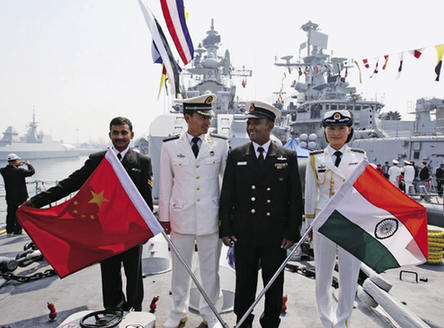This makes China nervous. India and China have an ambivalent relationship. On the one hand they have common interests based on growing trade and similar positions in the WTO and on climate change. On the other, they have abiding suspicions over the longstanding border dispute and what India sees as Chinese meddling in its own backyard - South Asia and the Indian Ocean region.
New Delhi is concerned about China's friendship with India's principal competitor in South Asia, Pakistan, and with its growing economic and military relationships in the Indian Ocean.
On its part, Beijing is deeply concerned about India's growing naval clout. It fears that India, possibly in collusion with the US, could interdict its oil in times of rising tension or war. Even though India is far weaker than China, it has the advantage of occupying a strategic "box seat" in the Indian Ocean. It also shares many commonalities with the US in terms of its longer-term strategic outlook and the two navies frequently exercise together.
All this gives rise to a classic "security dilemma" in the Indian Ocean region - one in which China fears India might cut off its oil and India fears China's counter-manoeuvres are intended to "surround" it.
If this were not bad enough, the Indian Ocean is surrounded by some of the poorest, most troubled countries in the world. It confronts enormous issues of poverty and food and water scarcity. It suffers serious non-conventional security threats - people-smuggling and trafficking, drug and gun-smuggling, piracy and a host of environmental and natural disaster challenges.
Any actions that would have the effect of deepening this security dilemma, such as the proposals floated in Washington to base US reconnaissance aircraft on the Cocos Islands and nuclear-powered submarines at HMAS Stirling, should be avoided. China would definitely interpret any such moves as an attempt to threaten its "soft underbelly" - its dependency on Middle East oil - during times of rising tension.
What is needed instead is a strategy designed to provide for joint action to alleviate the sense of insecurity on the part of the major powers that their legitimate interests in the Indian Ocean might not be met.
Unfortunately, the security-building mechanisms in the Indian Ocean are inadequate and show little prospects of improvement. Unlike the Asia Pacific, where four great powers (the US, China, Japan and Russia) to an extent balance each other, India is by far the dominant littoral power in the Indian Ocean.
Australia has the next most powerful navy, and it can only aspire to be a middle power.
This means India is able to dominate the security-building mechanisms in the Indian Ocean - no India, no viable mechanisms. As with any great power, India will use its influence to ensure its wishes are met. And those wishes have more to do with locking what it fears to be a China-Pakistan combination out than building a regime capable of solving some of the region's manifest problems so we can all "rise on the same tide".
Canberra should be working quietly to convince New Delhi that the best way to ensure that China doesn't seek a permanent military presence in the Indian Ocean region would be to work with it to alleviate its concerns.
This would not be a short-term prospect, however. Australia's challenge would be to convince Washington of this need, as much as it would be to convince India and China.
But we must make a beginning. The Indian Ocean must remain "the great connector", which has been its principal role throughout its long history.
If indeed US forces require reinforcing in the Indian Ocean, at the very least it will be important to ensure they are perceived to be, and are, designed to assist the region meet its multifarious security challenges. This would, in turn, require that Washington take a stronger interest in security-building mechanisms in the region than it has hitherto.



0 comments:
Post a Comment